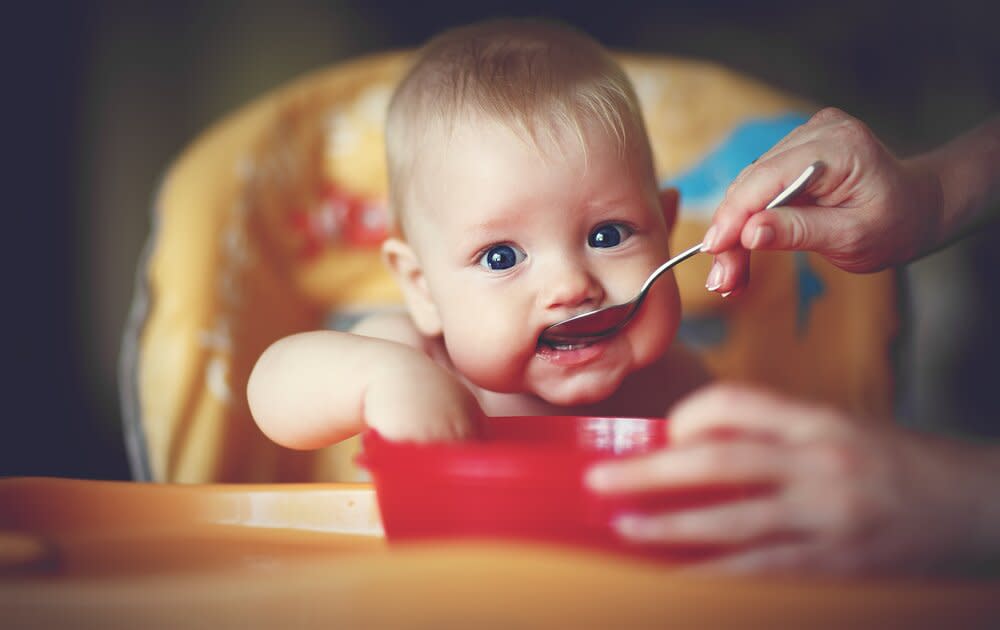7 Myths About Food Allergies and Kids

Evgeny Atamanenko/Shutterstock
More than 5 million kids in the U.S. have food allergies (that's about two in every classroom!), and though no one is entirely certain why, rates are on the rise. Yet there's still a lot of misinformation out there about food allergies, and some of it puts kids' lives at risk. So in honor of Food Allergy Awareness Week, let's debunk some of the common myths—because knowing the facts is critical and can even save someone's life.
Myth #1: You should avoid giving foods such as peanuts, fish, and eggs until your child is a toddler or preschooler.
Truth: Recommendations have changed. Because of new research showing that early exposure to common food allergens may actually help protect kids against developing allergies, it's now recommended that children at high risk for peanut allergies due to egg allergy or eczema be given peanut protein at 4-6 months if allergy testing is negative (and with the guidance and even supervision of a physician). The American Academy of Pediatrics also gives the green light to foods such as fish and eggs when babies start solids. Always talk to your pediatrician about your child's history before giving peanut or other common allergens.
Myth #2: Food allergies last a lifetime.
Truth: Though allergies to peanuts, tree nuts, fish, and shellfish are typically life-long, kids can outgrow allergies to milk, wheat, soy, and egg.
Myth #3: Food intolerances and food allergies are the same thing.
Truth: A food intolerance (such as lactose intolerance) is NOT a less severe form of allergy. It means you have trouble digesting a food, and eating that food may make you feel sick. A food allergy is a response from the immune system. Unlike an intolerance, eating the food you're allergic to (even a tiny amount) can be life-threatening. Make sure people caring for your child understand that no amount of that food is safe with a food allergy.
Myth #4: Epi-Pens are complicated to use.
Truth: An Epi-Pen contains medicine that can save someone's life if they're having a food-induced reaction. It may seem intimidating to use one, but it's actually not—and even if your own kids don't have allergies, knowing how to administer it is important if you children have friends over who carry one or if you work with kids in some capacity. Watch this quick video to learn how:
Myth #5: Peanut allergy is the only life-threatening allergy.
Truth: Any food can cause a serious reaction called anaphylaxis, which can be fatal. There are eight foods that cause most reactions: milk, egg, soy, wheat, fish, shellfish, peanuts, and tree nuts. Symptoms of anaphylaxis include difficulty breathing, swollen lips, vomiting, weakness, and confusion. If your child has a food allergy, download this free emergency care plan to share with people who care for your child.
Myth #6: Young kids are most at risk for dangerous food allergy reactions.
Truth: It's true that young kids, who may not be able to read food labels or understand the severity of their allergy, are vulnerable. But it's actually teens who are at the highest risk for a fatal food-induced anaphylactic reaction, likely due to risk-taking behaviors typical at that age.
Myth #7: Getting hives means the allergy isn't serious.
Truth: The severity of food-induced reactions can vary. If your child had a small patch of hives after eating a food once, he may have a more serious reaction the next time. And keep in mind that kids may describe allergic reactions in different ways—like "My throat feels funny," or "My tongue is hot."
Sally Kuzemchak, MS, RD, is a registered dietitian, educator, and mom of two who blogs at Real Mom Nutrition. She is the author of The Snacktivist's Handbook: How to Change the Junk Food Snack Culture at School, in Sports, and at Camp—and Raise Healthier Snackers at Home. She also collaborated with Cooking Light on Dinnertime Survival Guide, a cookbook for busy families. You can follow her on Facebook and Instagram. In her spare time, she loads and unloads the dishwasher. Then loads it again.

